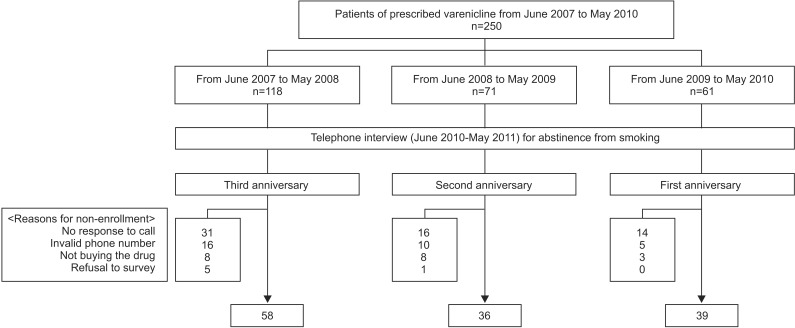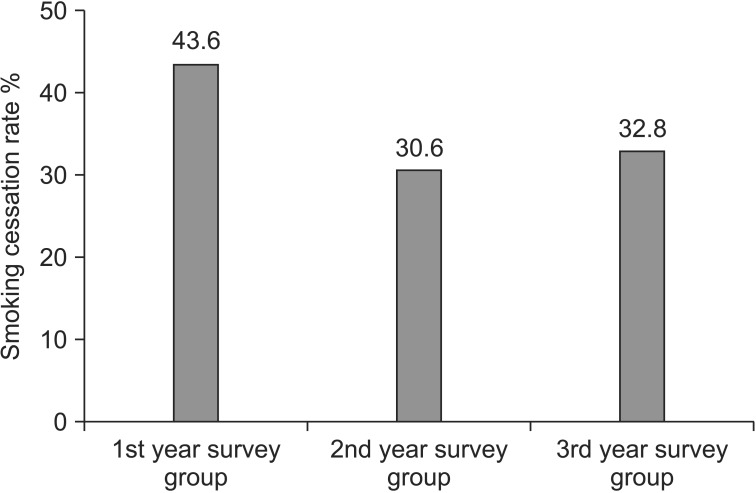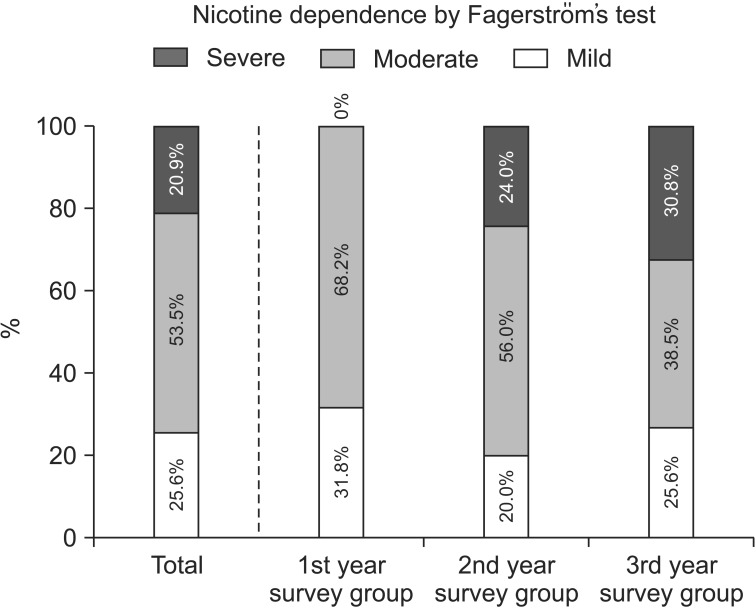Tuberc Respir Dis.
2015 Apr;78(2):92-98. 10.4046/trd.2015.78.2.92.
Seven-Day Continuous Abstinence Rate from Smoking at 1, 2, or 3 Years after the Use of Varenicline
- Affiliations
-
- 1Department of Internal Medicine, Chung-Ang University College of Medicine, Seoul, Korea. jykimmd@cau.ac.kr
- KMID: 2320600
- DOI: http://doi.org/10.4046/trd.2015.78.2.92
Abstract
- BACKGROUND
Varenicline, a selective partial agonist/antagonist of the alpha4beta2 nicotinic receptor, has proven effectiveness for smoking cessation by several randomized, controlled trials. Because few studies have evaluated the long-term efficacy of varenicline, we tried to evaluate the smoking status of varenicline users up to 3 years after the initial prescription of the drug.
METHODS
We interviewed varenicline users who were prescribed the drug from June 2007 to May 2010 by telephone, from June 2010 to May 2011.
RESULTS
One-hundred and thirty-three of 250 varenicline users (53.2%) were available for the survey. Seven-day continuous abstinence from smoking was adhered to by 17 of 39 respondents (43.6%) at 1 year, and 11 of 36 (30.6%) and 19 of 58 (32.8%) at 2 and 3 years since the first use of varenicline, respectively. Compared to current smokers, successful quitters were older (55.0 years vs. 49.9 years, p=0.01), had better compliance to the 12-week course (27.7 vs. 9.3%, p=0.01), and had taken varenicline longer (10.1 vs. 5.9 weeks, p=0.01). Fifty-four of 71 current smokers (76.1%) were willing to stop smoking in the near future. The preferred ways to cease smoking were will-power (48.1%), varenicline (25.9%), nicotine replacement therapy (11.1%), and others (14.9%).
CONCLUSION
Smokers should be encouraged to stick to the proven way for recommended period of time for successful cessation of smoking.
Keyword
MeSH Terms
Figure
Reference
-
1. Coe JW, Brooks PR, Wirtz MC, Bashore CG, Bianco KE, Vetelino MG, et al. 3,5-Bicyclic aryl piperidines: a novel class of alpha4beta2 neuronal nicotinic receptor partial agonists for smoking cessation. Bioorg Med Chem Lett. 2005; 15:4889–4897. PMID: 16171993.2. Hays JT, Ebbert JO. Varenicline for tobacco dependence. N Engl J Med. 2008; 359:2018–2024. PMID: 18987369.
Article3. Gonzales D, Rennard SI, Nides M, Oncken C, Azoulay S, Billing CB, et al. Varenicline, an alpha4beta2 nicotinic acetylcholine receptor partial agonist, vs sustained-release bupropion and placebo for smoking cessation: a randomized controlled trial. JAMA. 2006; 296:47–55. PMID: 16820546.4. Nakamura M, Oshima A, Fujimoto Y, Maruyama N, Ishibashi T, Reeves KR. Efficacy and tolerability of varenicline, an alpha4beta2 nicotinic acetylcholine receptor partial agonist, in a 12-week, randomized, placebo-controlled, dose-response study with 40-week follow-up for smoking cessation in Japanese smokers. Clin Ther. 2007; 29:1040–1056. PMID: 17692720.5. Tsai ST, Cho HJ, Cheng HS, Kim CH, Hsueh KC, Billing CB Jr, et al. A randomized, placebo-controlled trial of varenicline, a selective alpha4beta2 nicotinic acetylcholine receptor partial agonist, as a new therapy for smoking cessation in Asian smokers. Clin Ther. 2007; 29:1027–1039. PMID: 17692719.6. Cahill K, Stead LF, Lancaster T. Nicotine receptor partial agonists for smoking cessation. Cochrane Database Syst Rev. 2012; 4:CD006103. PMID: 22513936.
Article7. Jung JW, Jeon EJ, Kim JG, Yang SY, Choi JC, Shin JW, et al. Clinical experience of varenicline for smoking cessation. Clin Respir J. 2010; 4:215–221. PMID: 20887344.
Article8. Steinberg MB, Schmelzer AC, Richardson DL, Foulds J. The case for treating tobacco dependence as a chronic disease. Ann Intern Med. 2008; 148:554–556. PMID: 18378950.
Article9. Hajek P, Stead LF, West R, Jarvis M, Lancaster T. Relapse prevention interventions for smoking cessation. Cochrane Database Syst Rev. 2009; (1):CD003999. PMID: 19160228.
Article10. Aubin HJ, Bobak A, Britton JR, Oncken C, Billing CB Jr, Gong J, et al. Varenicline versus transdermal nicotine patch for smoking cessation: results from a randomised open-label trial. Thorax. 2008; 63:717–724. PMID: 18263663.
Article11. Nides M, Oncken C, Gonzales D, Rennard S, Watsky EJ, Anziano R, et al. Smoking cessation with varenicline, a selective alpha4beta2 nicotinic receptor partial agonist: results from a 7-week, randomized, placebo- and bupropion-controlled trial with 1-year follow-up. Arch Intern Med. 2006; 166:1561–1568. PMID: 16908788.12. Hsueh KC, Hsueh SC, Chou MY, Pan LF, Tu MS, McEwen A, et al. Varenicline versus transdermal nicotine patch: a 3-year follow-up in a smoking cessation clinic in Taiwan. Psychopharmacology (Berl). 2014; 231:2819–2823. PMID: 24522334.
Article13. Yilmazel Ucar E, Araz O, Yilmaz N, Akgun M, Meral M, Kaynar H, et al. Effectiveness of pharmacologic therapies on smoking cessation success: three years results of a smoking cessation clinic. Multidiscip Respir Med. 2014; 9:9. PMID: 24495744.
Article14. Anthonisen NR, Connett JE, Kiley JP, Altose MD, Bailey WC, Buist AS, et al. Effects of smoking intervention and the use of an inhaled anticholinergic bronchodilator on the rate of decline of FEV1. The Lung Health Study. JAMA. 1994; 272:1497–1505. PMID: 7966841.
Article15. Stapleton JA, Sutherland G, Russell MA. How much does relapse after one year erode effectiveness of smoking cessation treatments? Long-term follow up of randomised trial of nicotine nasal spray. BMJ. 1998; 316:830–831. PMID: 9565457.16. Fu SS, Partin MR, Snyder A, An LC, Nelson DB, Clothier B, et al. Promoting repeat tobacco dependence treatment: are relapsed smokers interested? Am J Manag Care. 2006; 12:235–243. PMID: 16610925.17. Rigotti NA. Clinical practice. Treatment of tobacco use and dependence. N Engl J Med. 2002; 346:506–512. PMID: 11844853.
- Full Text Links
- Actions
-
Cited
- CITED
-
- Close
- Share
- Similar articles
-
- Effect of Multi-modal Interventions for Smoking Cessation in a University Setting: A Short Course of Varenicline, Financial Incentives, E-mail and Short Message Service
- Smoking Cessation Rate and Related Factors of Varenicline in Clinical Practice
- Adherence to Varenicline and Abstinence Rates for Quitting Smoking in a Private Health Promotion Center-Based Smoking Cessation Clinic
- Effectiveness of Smoking Cessation Using Motivational Interviewing in Patients Consulting a Pulmonologist
- Craving and treatment in smoking




